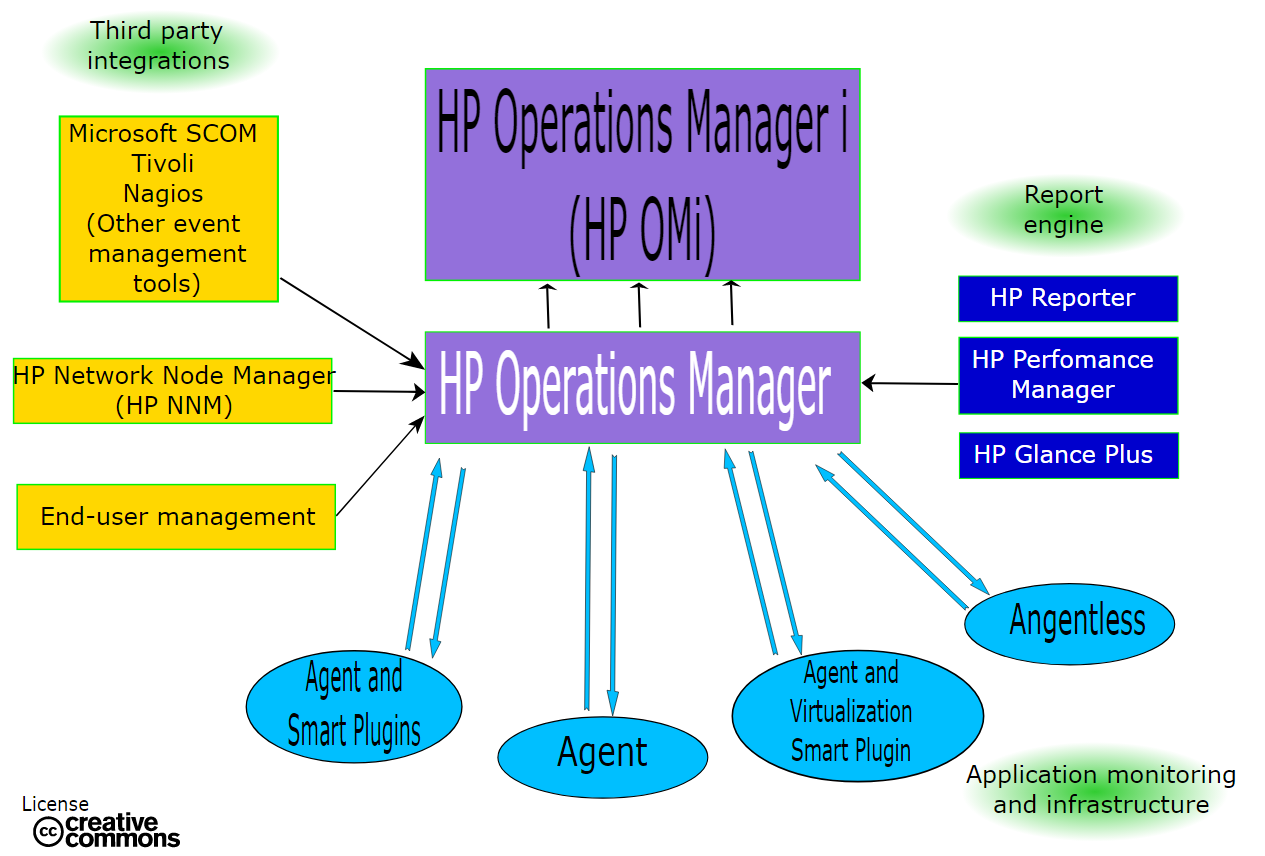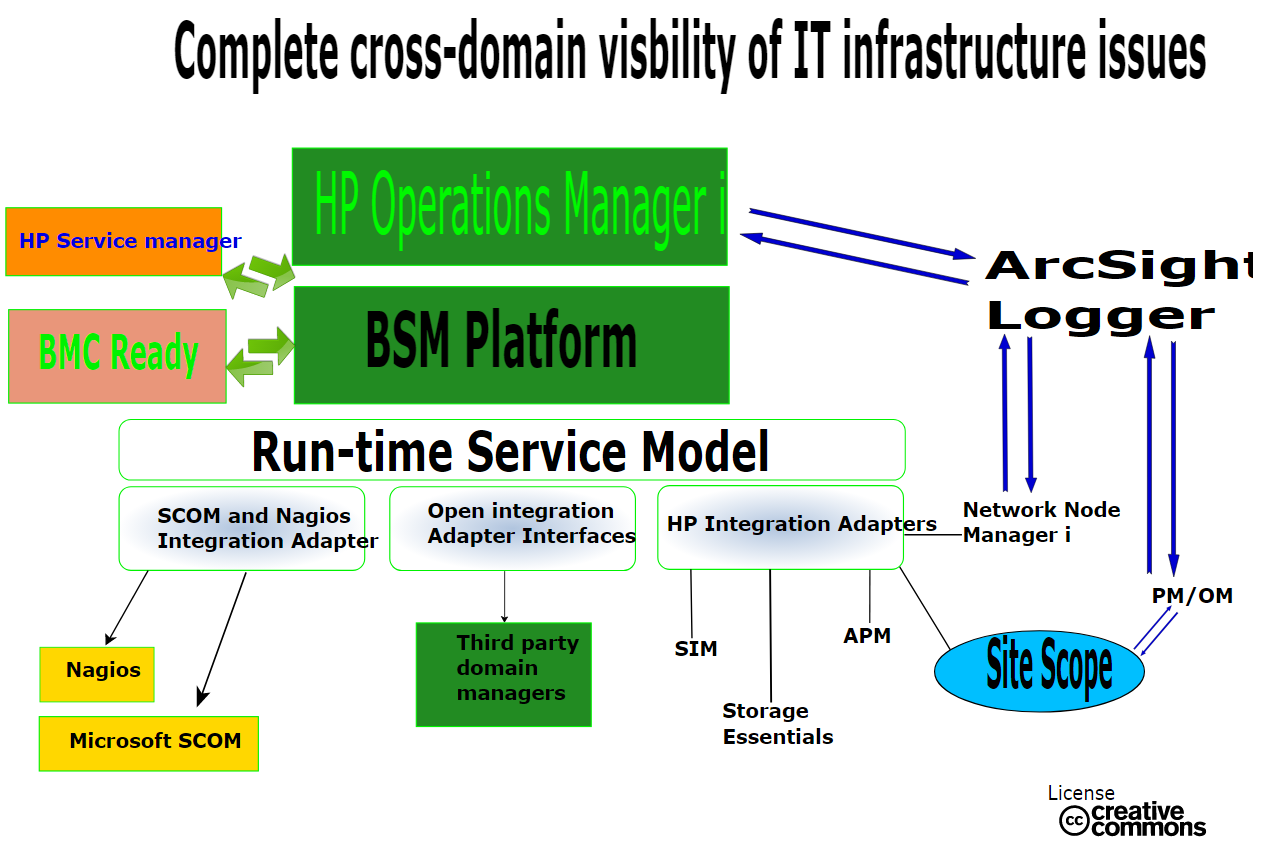
| Version | Summary | Created by | Modification | Content Size | Created at | Operation |
|---|---|---|---|---|---|---|
| 1 | Dean Liu | -- | 1305 | 2022-10-13 01:33:25 |
Video Upload Options
HP Operations Manager is a System monitoring package manufactured by Hewlett-Packard (HP). HP Operations Manager is part of HP Operations Center that includes too: On May 20, 2015 HP started the migration for HP OM users to Operations Manager i, very similar names for very different softwares architectures. On September 1, 2016 HP Enterprise announced the End of Sale of HP Operations Manager for Windows (OMW) 9.0x and HP Operations Manager for Windows Basic Suite (OMW BS) 9.0x and all customerswas migrate to HPE Operations Bridge Suite, a hybrid IT monitoring solution.
1. Agents Characteristics

It operates in 'agent-push' mode, which means that a software agent component installed on the monitored hosts sends selected alerts to a centralized Management Server.
These agents carry out the instructions specified in HP-OM rule-sets called Policies. Distributing this processing around the client nodes reduces the load on both the management server and the network, by configuring these policies[1] to select and transmit only the events that are needed, unlike the communication-heavy SNMP method. However, SNMP can be used where there is no supported operating system on the client equipment.
The main task of the agent is to classify each event before transmission (or ignore it), so that the management server can route the messages to the appropriate destinations, which can include operator consoles, trouble-ticket systems, and notification systems.
Internally, policies are stored as XML files and distributed from the management server to the managed nodes selected by the administrator, or which have been auto-discovered as needing those policies.
A specialised form of pattern matching[2] is extensively used to parse events and to pass key variables on to other components of HP-OM, such as the various fields of the output message and the automatic actions, and to generate keys for correlation (see below).
2. What Can Be Monitored?

Policies can get events from various sources:
- The opcmsg utility, which can be programmed into your own scripts to send a message direct to the agent.
- User-specified programs which return numeric values (via the opcmon utility) to be compared with thresholds that are easily set in the policies. This is much more controllable than burying threshold values inside programs.
- Log file tailing.
- User-specified programs returning text output.
- Windows Management Instrumentation.
- SNMP traps - SNMP v3 on the way soon.
- SNMP GetRequest
- Service and process status
- Performance Metrics. These are collected on all managed nodes, and can also be accessed graphically using the now-integrated Performance Manager.
3. Supported Operating Systems (HP-OM Native Agent)
- Unix
- AIX
- HP-UX
- Solaris
- Microsoft Windows
- Linux
- Red Hat Enterprise Linux
- Centos
- SUSE Linux Enterprise Server
- Debian
- Ubuntu
- Oracle Linux
- NonStop Kernel
4. Supported via Third-party Software
- AS/400
- IBM Mainframe (z/OS)
HP Operations Manager can monitor the status and health of the IBM Mainframe (z/OS) and iSeries (formerly AS/400) systems and their applications with the EView/390z and EView/400i add on products from EView Technology. The EView solutions enable HP Operations Manager to consolidate event and system performance management of the IBM environments under a common HP Operations Manager console.
Other third-party software solutions are available in the form of Smart Plug-Ins from NiCE IT Management Solutions. The NiCE solutions extend the view of HP Operations Manager and include solutions like the BlackBerry SPI, DB2 SPI, and the Domino SPI.
5. Add-on via Third-party Software
- "System Center 2016 Integration Pack for HP Operations Manager" for Windows Server 2012 R2 or Windows Server 2016 with System Center 2016 Orchestrator installed.[3][4]
6. Supported Platforms (Central System)[5]
- HP Operations Manager on Linux
- Red Hat Enterprise Linux 5.2 to 6.5 (x64)
- HP Operations Manager on Unix
- HP-UX 11.31 (IA-64)
- Oracle Solaris 10 (sparc)
- HP Operations Manager for Windows
- Windows Server 2003 and 2003 R2 Standard, Enterprise, Data center Edition
- Windows Server 2008 and 2008 R2
- Windows Server 2012
7. 'Noise' Reduction
Excessive alerting is reduced by various forms of de-duplication being configurable at the agent, and also by correlating events using configurer-specified keys. Many correlation keys are included with the various Smart Plug-Ins that can be added to the basic product.
The effects of de-duplication and correlation are slightly different. De-duplication results in only one event being presented, effectively summarising a given number of events occurring close together over a stated timespan. Correlation occurs when an older event is consigned to the Acknowledged message list because its key matches an "acknowledge these" pattern (here's the HPOM pattern match again) in a later message, which normally remains on the Active message list.
Because correlation occurs at the management server (so as to be able to correlate events from different managed nodes), it does not reduce traffic to the management server. On the other hand, effective use of de-duplication at the managed node will reduce such traffic.
As a last resort, message overload conditions can be dealt with by an optional de-duplication at the management server, and by a detection mechanism which can quench individual agents when defined maximum frequencies are reached.
8. Outputs
Once the events have been received by the management server, end users, called Operators, can manage the messages, and the servers they came from, using various types of console. Unix/Linux management servers are accessed using either a Motif GUI or a Java based GUI. Microsoft Windows management servers are accessed using either an MMC snap-in console or a web-based console.
An additional web console (connected to the bundled-in Performance Manager) can be used to plot graphs of historical data collected by the agents. New graphs can be created as required, and the stored metrics can be analyzed to produce forecast graphs.[6]
Alarms can be filtered depending on the user's role within the organization.
Various trouble-ticket systems such as Remedy ARS, HP Service Manager can be connected.
Outputs to pagers, SMS, e-mail etc. are accomplished by connecting a third-party notification system such as xMatters or TelAlert or Enterprise Alert.
9. Remote Control
An alert condition can have two types of action configured along with it :-
- Automatic actions: will execute at the time of the alert, e.g. an automatic fix.
- Operator Initiated action: Started by the Operator, e.g. a standard fix requiring a human decision.
More powerfully, sets of tools are provided and can be added to by the implementor, to remotely run any character-based utility or script without logging into the client machine. This can dramatically reduce administration costs by enabling bulk processing of routine tasks across many servers.
10. History
HP OpenView 'Operations Centre' was originally built upon the foundation of Hewlett-Packard's Network Node Manager (NNM) product. The Windows version 'OvOW' was built separately from NNM, and the Unix product stream is now also separated (as from NNMi 8.x and OM 9.x).
Along the way it became known as VantagePoint, before finally relinquishing the 'OpenView' tag altogether. This accounts for many objects still being prefixed OpC, Ov and VP. Finally in 2007 it was rebranded "HP Operations Manager".
Unix and Windows product streams have been converging for some time. Whereas they are inter-operable to a large extent, they still retain some individual strengths and differences.
Another convergence is that of the Operations product with the Performance product. These used to be available separately, and have some overlap in monitoring functions. The original separate agents, while now purchased, licensed and installed together, still retain separate features and separate image names. They are currently benefitting from an increase in cross-fertilization: the Operations sub-agents feeding metric values into the performance history base, and the Performance sub-agents making a huge range of metrics available for threshold monitoring by the Operations policies.
11. Versions
HP Operations Manager (OM) — monitor systems and applications using agents
- for MS Windows - 9.00 (OMW)
- for Unix - 9.22 (OMU)
- HP Operations Agent is currently in version 12.x, for both OMW and OMU
References
- Video overview of policy configuration - https://www.youtube.com/watch?v=cM2ik2mbZO0
- Video on HPOM pattern matching at https://www.youtube.com/watch?v=aLxXSr9XB_8
- "System Center 2016 Integration Pack for HP Operations Manager" (in en-us) (html). Microsoft, Download Center. https://www.microsoft.com/en-us/download/details.aspx?id=54100. "The Integration Pack for HP Operations Manager is an add-on for System Center 2016 Orchestrator that enables you to create activities within runbooks that make requests to the HP Operations Manager product to get data or perform functions."
- "HP Operations Manager Integration Pack for System Center 2016 - Orchestrator" (in en-us) (html). 24 April 2017. https://docs.microsoft.com/en-us/system-center/orchestrator/hp-operations-manager-integration-pack?view=sc-orch-1807. "The Integration Pack for HP Operations Manager is an add-on for System Center 2016 - Orchestrator that enables you to automate the consolidation and correlation of fault and performance events across you entire physical and virtual IT infrastructure."
- All Supported Platforms are available from the HP Software Support Matrix (SUMA) available at http://support.openview.hp.com/selfsolve/document/KM323488 (HP Passport login required) - updated monthly.
- "HP Operations Manager Monitorización de Servicios TI" (in spanish) (html). http://www.abast.es/gestion-ti/soluciones-de-gestion-ti/hp-operations-manager/. "HP OM ofrece gestión integral, gestión de alarmas y eventos, supervisión proactiva del rendimiento, alertas automatizadas, informes y gráficas para los sistemas operativos, middleware y aplicaciones. El resultado es la consolidación y optimización de las operaciones mediante una consola única para toda su infraestructura de TI, aunque sea un entorno heterogéneo."




